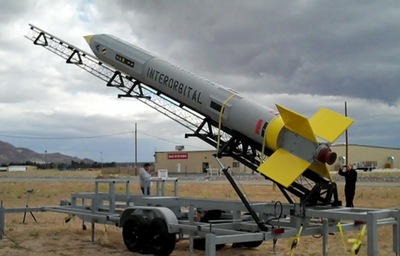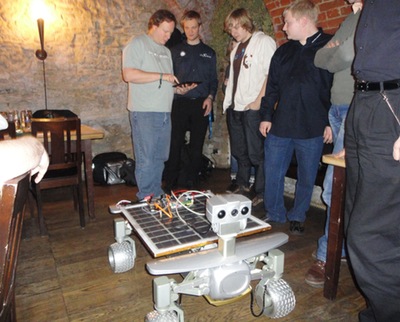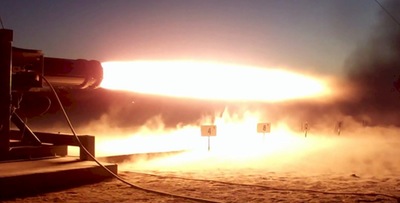Rocket science on a shoestringby James Careless
|
| For IT professionals, the emergence of such companies offers a new career frontier; one where they literally have the chance to do rocket science—on a shoestring budget. |
SpaceX isn’t the only private company to achieved space flight, which was once the sole preserve of well-funded government agencies. Orbital Science Corporation’s Cygnus cargo spacecraft berthed with the ISS last September and again last month. Meanwhile, Richard Branson’s Virgin Galactic is on the verge of commencing suborbital flights for space tourists in the company’s SpaceShipTwo reusable spaceplane.
These are just the most visible private companies pursuing space flight; there are many more scattered across the world. For IT professionals, the emergence of such companies offers a new career frontier; one where they literally have the chance to do rocket science—on a shoestring budget.
 A single Common Propulsion Module test Vehicle (CPM-TV) developed by IOS. A bundle of five of these units make one NEPTUNE 5 (N5) satellite launcher. (credit: Interorbital Systems) |
Multitaskers required
The budget realities of private industry, coupled with the tremendous computing and control capabilities of modern IT, means that private space IT departments are mean and lean. These are small teams of multitaskers; not the legions of job-specific programmers/designers employed by government agencies like NASA.
A case in point: Interorbital Systems (IOS) is a US company that is designing, prototyping, and manufacturing the NEPTUNE series of modular rockets. The more lift and altitude required, the more NEPTUNE Common Propulsion Modules (CPMs) that are combined, increasing the number of uber-small affordable satellites like the TubeSat and CubeSat that can be carried in a single launch (currently it’s 24 per flight). In 2009, the Mojave-based company began offering its Personal Satellite-Kit-and-Launch for an academic price of $8,000. To date, IOS has 77 small satellites—most built using the company’s own kits—on its launch manifest for three upcoming orbital missions beginning in 2014.
“Our overall objective is to provide the lowest-cost access to space, so as a launch vehicle provider, we’re popular among the nano- and pico-satellite customers,” said Dr. Sarah Warren Rose, Interorbital Systems' Lead Mechatronics Engineer. “Our second goal is to provide rapid-response, meaning the ability to launch within weeks or hours of an order, and to conduct those orbital launches with mobile sea- or land-based systems. Our third objective is to win the Google Lunar X PRIZE (with our team SYNERGY MOON) and start scientific, cargo, and human launch services to the Moon and beyond—with a very keen focus on Venus, the long-time favorite destination of Interorbital’s founders.”
Despite all these ambitious goals, “We have a core of four people contributing to all IT demands,” said Dr. Warren Rose, who is responsible for all computer systems outside the engine: namely guidance, control, and navigation (GNC) and communications. Everything else is divided up among the remaining three IOS IT people, including IOS founder/CTO Roderick Milliron, who developed a fuzzy-logic approach to rocket control; and investor/coder Eric Gullichsen, who contributed early work in genetically evolving algorithms for GNC. Engineer Louis Donesa completes the IT team with trajectory and rocket performance analysis.
At Interorbital Systems, “The best IT skills are communications protocols—all kinds—and a natural inclination for a variety of computer platforms,” Dr. Warren Rose said. “We work with all types of microcontrollers, microcomputers, and computers to build as much of the hardware ourselves, or find the most inexpensive solution. For example, a data-logging cell phone is great back-up for the on-board GPS receiver and memory card.”
Copenhagen Suborbital’s (CS) IT department is also remarkably small. Based in Denmark, this company is developing its own HEAT 2X suborbital rocket booster and Tycho crewed capsules.
| “In terms of unique IT problems in our industry, there’s one big problem: The inability to test instruments and components in their operating environment” of space, Dr. Warren Rose explained. |
“The software development in CS concerning with Mission Control and on-board software are done by four people,” said Steen Andersen, the CS Flight Dynamics Officer/software engineer responsible for flight control and monitoring, plus electronics design for the CS spacecraft and payload. These four people are working independently on all aspects of designing and controlling a working spacecraft. And because CS is a startup company, there’s only enough money to allow founders Peter Madsen and Kristian von Bengtson to work full-time! “So we are basically doing what is done in other IT and software development departments—like requirements, system design, development and testing—like a professional company but in the limited time that is set aside to a spare time project like Copenhagen Suborbital,” Andersen said.
“The real challenge of the project is doing what has only been done by large governmental agencies in an amateur based organization,” he added. “The project relies on the will and passion of trying to reach for the 100-kilometer limit with a human on board with only around 50 people working together.”
 Members of Part-Times Scientists work on a rover they hope to eventually send to the Moon. (credit: W. Faler) |
Channelling MacGyver is a must
For those too young to remember, MacGyver was a US TV show featuring Richard Dean Anderson (pre-Stargate) as a brilliant scientist/secret agent. A “MacGyver” refers to one of the many brilliant ad hoc technical solutions that agent Angus MacGyver would devise to get out of trouble. These included plugging a leaking sulphuric acid tank with chocolate (proved possible by Mythbusters), using candlesticks and a microphone cord to make a heart defibrillator, and building a lie detector out of an alarm clock, blood pressure cuff, and stethoscope.
Now MacGyver’s specific approach to rocketry—hit a handheld flare with a rock and hang on—has not been embraced by the private spaceflight industry. But his overall emphasis on working “miracles with minimals” definitely has; simply because money is very, very tight.
Interorbital Systems has already grasped this point, by using data-logging cell phones as backup in-flight GPS receivers/memory cards. But IOS’s willingness to “MacGyver” a solution doesn’t end here; not by a long shot!
“In terms of unique IT problems in our industry, there’s one big problem: The inability to test instruments and components in their operating environment” of space, Dr. Warren Rose explained. “So there are multiple examples of how we’ve solved this problem for different systems or devices with what we have available to us on Earth.”
For instance, to test IOS’s Inertial Measurement Unit (IMU), which uses three digital gyroscopes, three digital accelerometers, and three digital magnetometers to help the spacecraft know its real-time position in three-dimensional space, Dr. Warren Rose connected an IMU to a microcomputer and took the pair on a rugged California desert road trip from Mojave to San Diego. “The data I gathered over the three days confirmed the instrument’s operational functions and the reliability of the system over a long period of time,” she said; “namely bouncing around in the back of a car.”
For another IMU test, IOS bought a set of quad-copter motors and propellers to customer-build their own computer-controlled flying test platform. “I made a lightweight quad-copter frame from fiberglass and circuit boards, used a microcomputer for data processing and communication, and a microcontroller for the power system, along with some lithium ion battery packs,” said Dr. Warren Rose. “We soon had an ultra-low-cost, autonomously flying guidance-software test platform that could give us real-time, three-axis performance data.”
The payoff from this MacGyver solution? “This tiny flying robot provided a short-turnaround, low-cost method to run initial tests and to identify bugs in our control algorithms through observations during actual flight—without having to build, launch, and possibly destroy a vastly more expensive rocket,” she said. “Now we can proceed with our upcoming test launches with confidence that the code is clean, functional, and ready for actual rocket test flight applications.”
Getting in on the ground floor
Obviously, not all IT people come with the mechanical engineering skills Dr. Warren Rose had at hand to build her MacGyvered solutions. But they don’t need to: There are plenty of opportunities for those with coding skills to find their way into private space IT. Moreover, it is possible for an IT professional to keep their day job, as Steen Andersen does, and get into private space IT at their own speed and schedule.
| “For IT professionals who want to conquer this ‘final frontier’—either as a career or a passion—there are lots of opportunities and adventures available,” said Faler. |
Wes Faler is one such person. During business hours, he owns and operates Fluid & Reason, LLC; a Tampa company that writes software for the EPA and other major government/business clients. But on his own time, the man who is rekindling a teenage dream of a new ion rocket engine works with a range of private space flight projects such as KickSat. A crowdfunded effort, KickSat advocates using cracker-sized “Sprite” spacecraft, each one small and cheap enough for the average person to build and program.
“Run by Zachary Manchester, KickSat’s goal is to launch these Sprites together in a CubeSat, where they would be stored like crackers in a cracker box and then deployed once in low Earth orbit,” Faler said. “The signals from the spacecraft would be picked up by radio amateurs around the world such as myself, while the spacecraft themselves burn up after a while, when they re-enter the atmosphere.”
Today, Wes Faler is one of KickSat’s 315 backers. “I purchased one of the Sprite crafts to write software that had to fly in space,” he said. “It’s been quite incredible how everyday skills translate to space, albeit with less ability to debug, of course.” Others seem to agree, as KickSat exceeded its $30,000 funding goal, raising $74,586 on KickStarter.
This is just one of many space projects that Wes Faler donates his time to. Others include FUNCube (funcube.org.uk), the British radio amateur educational satellite project; Part-Time Scientists (ptscientists.com), which is competing for the $30 million Google Lunar XPRIZE by building their own lunar rocket, spacecraft, and lunar rover; and a test of his own ion engine on a satellite to be launched by Interorbital Systems.
“Have you ever gotten a 3D printer up and running?” Faler asked. “If so, you’ve dealt with hardware issues that just aren’t in the datasheets, and you’ve got a future in lab automation and driver development for real spacecraft.”
The bottom line: There are lots of ways for IT people to get into space flight today; either on a full-time or part-time basis. “Although I may not have made my career in NASA, I have found many meaningful ways to be part of private spaceflight IT,” said Faler. “For IT professionals who want to conquer this ‘final frontier’—either as a career or a passion—there are lots of opportunities and adventures available!”
